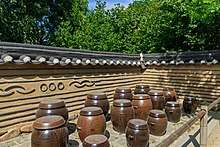Jangdokdae
Jangdokdae (Hangul: 장독대) or Jangttokttae is an outside space, most frequently a terrace, where a series of jars are gathered.
| Jangdokdae | |
Jangdokdae at Gyeongbok palace in Seoul | |
| Korean name | |
|---|---|
| Hangul | |
| Hanja | 醬-臺[1] |
| Revised Romanization | jangdokdae |
| McCune–Reischauer | changtoktae |

The jars are a subkind of Jangdok (or Onggi), a Korean ethnic earthenware. They are used to ferment or simply store comestible goods, typically Kimchi, soybeans, bean and red pepper paste[2] or grains.
Jangdok (Hangul: 장독) means "crock" (for condiments and soy sauce)[3] and dae (Hangul: 대) means "place", "support"... so jangdokdae (Hangul: 장독대) means "place for jangdok(s)". The jars are called hangari (Hangul: 항아리)[4] or onggi (Hangul: 옹기).[5]
This place is commonly found directly near traditional Korean houses, more precisely near the kitchen. Sunshine and ventilation are key aspects in the location choice, so that foods can be preserved and kept fresh.[5] Well-preserved ingredients may stay for several years in the jars.
The similar terraces of royal palaces were called yeomgo (염고) and were supervised by a court lady, called janggo mama (장고 마마).[6]
References
- "장독대". Naver Hanja Dictionary. Retrieved 2017-02-20.
- Korean Culture and Information Service (KOCIS). "The Wonders of the jangdokdae". Korea.net. Retrieved 10 December 2014.
- "장독 醬-". Naver Dictionary. Retrieved 2017-02-20.
- "Rice Cake and Traditional Kitchen Utensils Museum". My Korean Kitchen. Retrieved 10 December 2014.
- "Korea Information". Asia-planet.net. Archived from the original on 4 March 2016. Retrieved 10 December 2014.
- Sunhwa Rha (2006). Pottery: Korean Traditional Handicrafts. Ewha Womans University Press. p. 119. ISBN 9788973006823.